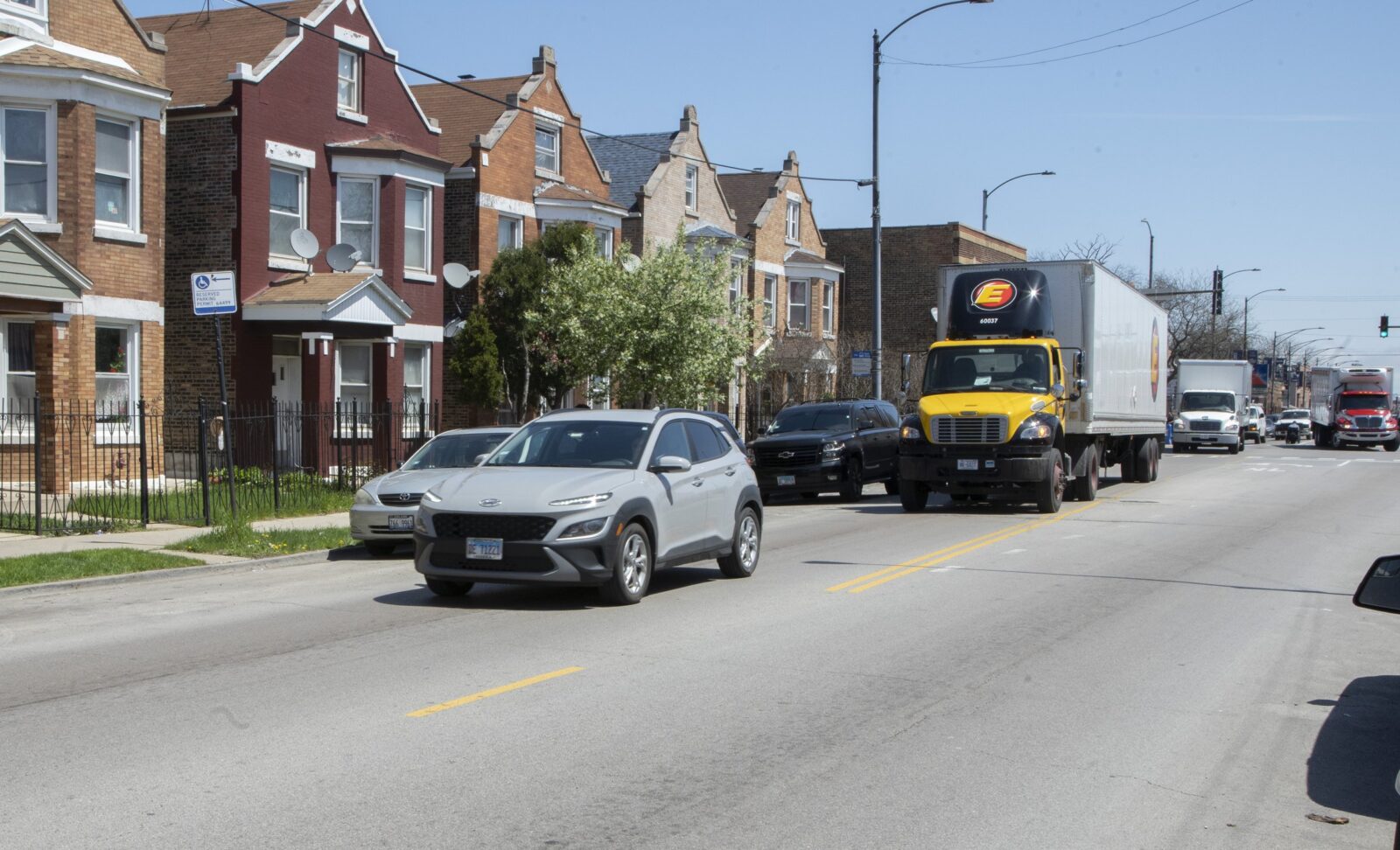WBEZ and MuckRock collaborated with Northwestern University to create the map using data from 94 Microsoft sensors installed on CTA bus shelters last summer on air pollution. The map highlights areas of the city where pollution levels are highest.
Particulate matter can trigger asthma attacks, lung and heart disease, and premature deaths. Air flow, wind and geographical features like valleys affect where pollutants end up.
Particulate Matter
Particulate matter is a group of tiny air pollutants that include soot, dust, droplets of liquid and smoke. They range in size from large particles visible to the naked eye (like those you see in smoke or haze) to very fine ones (called PM2.5). PM2.5 are so small that they can reach deep into your lungs all the way to the tiny air sacs called alveoli, where they irritate and corrode the walls, causing lung damage and contributing to heart disease and lung cancer.
Several studies show that people who live near roadways are at a greater risk for exposure to these harmful particles, which are the result of emissions from vehicles, wood stoves, campfires and other sources. They also contribute to reduced visibility known as haze. Particulate matter in outdoor air can also enter buildings through windows, doors and ventilation systems and from smaller cracks and crevices.
In Chicago, where the influx of new residents is adding to existing emissions, the pollution from cars and trucks is particularly harmful. Because PM2.5 penetrates the lungs deeply, it can be especially harmful to children and older adults. It also exacerbates lung diseases, like asthma and COPD.
Using data from 94 Microsoft sensors around the city, WBEZ and MuckRock used this new tool to identify air pollution hotspots. The results confirm that communities located along expressways and in industrial areas, especially those in the South and East Sides, are overburdened with ozone and particulate matter.
The results show that Black and Latino neighborhoods in Chicago are particularly impacted by the presence of these pollutants, which have been linked to health problems including respiratory infections, asthma attacks and premature death. The burden of these pollutants is disproportionately carried by communities of color and low-income populations, which have less access to resources that can help them combat the effects of polluted air.
The new Microsoft tool allows you to zoom in on the locations of these hotspots and see how levels of ozone, PM2.5 and nitrogen dioxide differ across the city. For example, the high concentrations of ozone and PM2.5 in Little Village, Pilsen and the far Southeast Side are driven by the many diesel trucks that travel through those communities on a daily basis.
Gases
Air pollution comes in a variety of forms, including coarse dust and pollen or fine particles that can get trapped in the lungs. But gases such as nitrogen dioxide and ozone are especially dangerous, and can cause breathing problems, lung damage and premature death in the long run. The ozone gas in particular is linked to asthma, respiratory infections and other health issues.
In June, Cook County had its worst ozone readings in eight years. Ozone levels have risen due to higher temperatures and a rise in emissions, especially from burning fossil fuels.
Nitrogen dioxide is also associated with vehicle and industrial emissions, and it contributes to the formation of ozone. Both of these pollutants have been linked to heart disease, respiratory infections and cancer in the short term and to lung diseases such as asthma and chronic obstructive pulmonary disease in the long term.
Across the nation, the Cook County metropolitan area ranks 22nd out of 221 metro areas in year-round exposure to particulate matter 2.5, which is made up of fine particles that can travel deep into the lungs and enter the bloodstream, where they can cause heart attacks and strokes. The area is more polluted than Bakersfield, California, and Los Angeles, but less so than New York City, which tops the list.
Particulate matter 2.5 is primarily created by coal combustion, with natural gas also a significant source. Over the past decade, the region has shifted away from coal and into cleaner natural gas, which has reduced its overall pollution, but not as significantly as the shift away from coal would have been without the switch to natural gas.
Neighborhoods in the far South and West Sides, and parts of the Southwest side, suffer the highest levels of exposure to pollution from vehicles and heavy traffic. But in the North and Northwest sides, where there is more truck traffic, pollution levels are lower. A MuckRock analysis of data collected by Microsoft, which placed 115 sensors on CTA bus shelters last summer, reveals that some neighborhoods still experience disproportionate levels of air pollution.
Ozone
As the summer heat and sunlight increase, chemical reactions in the atmosphere produce ground-level ozone. When combined with particulate matter, ozone forms the stuff we know as smog. Ozone is a respiratory irritant that can trigger asthma attacks and make it harder to breathe for people who already have lung diseases like COPD. It can also damage the respiratory system of healthy people, including children. It is the main reason for the thirteen “air pollution action days” we have had this year in Chicago, the most the area has seen since 2012.
Ozone also reduces the ability of plants to absorb solar ultraviolet radiation and can damage skin. So people who spend a lot of time outdoors, especially those with fair skin and light-colored hair, are at higher risk from exposure. Scientists call these people “sensitive groups” and recommend that they avoid vigorous outdoor activities on days when ozone levels are high.
The same research that identifies ozone hotspots also points to places with elevated concentrations of fine particulate matter. These pollutants are 2.5 micrometers in diameter or smaller and can lodge deep in the lungs. They are a major cause of heart and lung disease and may contribute to birth complications, cognitive problems and premature death. Particulate matter is the single largest environmental contributor to death, and researchers say the harm it causes is comparable to that caused by cigarette smoking.
Researchers analyzed fine particulate matter in neighborhoods across the city using a combination of data sources, including satellites and Microsoft sensors. They then compared the data to health and demographic information about residents in each neighborhood. The results showed that low-income communities of color have disproportionately heavy burdens of air pollution. For example, in the South Side neighborhoods of Back of the Yards and Riverdale, where high levels of air pollution are concentrated, the majority of households are black or Hispanic.
To lower the health risks of high ozone and fine particulate matter levels, the city and its residents need to cut down on car traffic, power plant emissions, gas-powered lawn mowers and other sources of pollution, as well as take steps to protect indoor air quality. But this will require a significant political commitment from a new administration that has yet to show that it can live up to its promises of clean air and good jobs for all.
Nitrogen Dioxide
When it comes to the smog that pollutes our air, nitrogen dioxide (NO2) is the key. When NO2 mixes with other pollutants like particulate matter and sunlight, it forms ozone. Ozone is dangerous to people with heart and lung conditions, including asthma, because it can make breathing difficult. Exposure to high levels of ozone can also increase the risk of heart disease, stroke, and respiratory infections.
Nitrogen oxides come from sources like car and truck exhaust, as well as chemical solvents, factories, and metal degreasers. They can be especially hazardous in low-lying areas where the ground is moist and can trap pollutants near the surface, making them more likely to be breathed into the lungs. This is why NO2 concentrations are highest along highways, where cars and trucks produce more emissions.
In addition to being a harmful pollutant on its own, NO2 is a precursor to other harmful pollutants, so reducing its emissions can help reduce the amount of other pollutants we need to worry about. Studies have linked elevated levels of NO2 to increased hospital and emergency room visits for respiratory symptoms, decreased lung function, and reduced life expectancy.
A new map from the Chicago Tribune, WBEZ and MuckRock shows the hyperlocal distribution of nitrogen oxide pollution in our city. It shows that neighborhoods with a large percentage of people of color, such as Little Village, Pilsen and the far Southeast Side, are most exposed to pollution. But the map doesn’t show the whole picture, since Microsoft’s sensors only cover a few hundred blocks of the city.
While this data is a good start, we need more sensors in more places to get a more complete picture of our air quality. Until then, we can only guess at how much pollution our neighbors are exposed to, and how it affects their health. For residents in these communities, a clearer picture of the dangers they face can help them push for change. And that requires knowing exactly where the pollution hotspots are so they can organize to protect their families and communities.

















Leave a comment